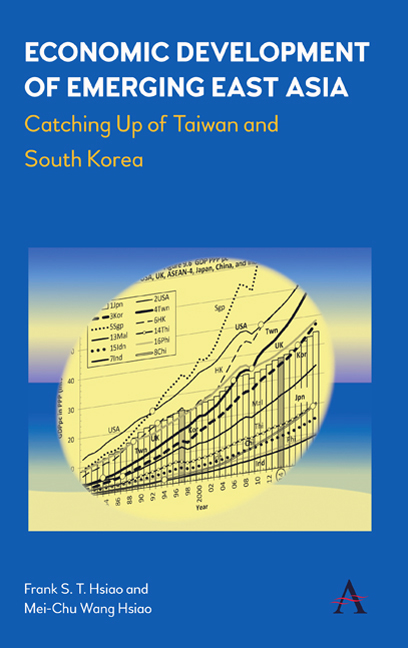Book contents
- Frontmatter
- Dedication
- Contents
- List of Figures
- List of Tables
- Sources of the Chapters
- Acknowledgments
- About the Authors
- Introduction
- Part I Studies of Emerging East Asian Economies: Taiwan and Korea
- 1 Some Development Indicators of Taiwan: A Comparative Study of East Asia in the Early Postwar Period
- 2 Capital Flows and Exchange Rates during the Asian Financial Crisis: Recent Korean and Taiwanese Experiences and Challenges
- 3 Productivity Growth in Newly Developed Countries: The Case of Korea and Taiwan
- 4 Korean and Taiwanese Productivity Performance: Comparisons at Matched Manufacturing Levels
- 5 Colonialism, Learning and Convergence: A Comparison of India and Taiwan
- Part II Catching Up and Convergence in East Asian Economic Growth
- Index
4 - Korean and Taiwanese Productivity Performance: Comparisons at Matched Manufacturing Levels
from Part I - Studies of Emerging East Asian Economies: Taiwan and Korea
Published online by Cambridge University Press: 10 January 2018
- Frontmatter
- Dedication
- Contents
- List of Figures
- List of Tables
- Sources of the Chapters
- Acknowledgments
- About the Authors
- Introduction
- Part I Studies of Emerging East Asian Economies: Taiwan and Korea
- 1 Some Development Indicators of Taiwan: A Comparative Study of East Asia in the Early Postwar Period
- 2 Capital Flows and Exchange Rates during the Asian Financial Crisis: Recent Korean and Taiwanese Experiences and Challenges
- 3 Productivity Growth in Newly Developed Countries: The Case of Korea and Taiwan
- 4 Korean and Taiwanese Productivity Performance: Comparisons at Matched Manufacturing Levels
- 5 Colonialism, Learning and Convergence: A Comparison of India and Taiwan
- Part II Catching Up and Convergence in East Asian Economic Growth
- Index
Summary
Abstract
In growth theory, industrial productivity is the major factor driving economic growth. Instead of using conventional measures of total factor productivity, we use the weighted Malmquist productivity index, which was developed only recently, and its components, the efficiency index and the technology index.
Following the previous chapter, this chapter also compares the productivity performances of 15 matched manufacturing sectors in Korea and Taiwan. Using Maddison's data, we first ascertain that Taiwan and Korea are at the same development stage. The distance functions are derived by using the Malmquist productivity indexes, based on category-wise metafrontiers, 1978–96. Comparisons at the sector levels are made using sequential multiplicative products of the indexes.
We find that during this period, the overall productivity and technology growth rates of Taiwan were higher than those of Korea. This is also shown at disaggregated levels. While there are many similarities between the two countries, the productivity and technology growth rates of the high-tech industries in Korea are much larger than those of Taiwan, and more high-tech sectors in Korea are leading innovators compared to Taiwan. In contrast, Taiwan's high overall growth rate rested mainly on its traditional and basic industries. The differences are chronic rather than transient.
Our results indicate that there are several signs that Korea is catching up with Taiwan in productivity at long last. Their performance in the next decade will be of interest to watch.
Introduction
The rapid postwar growth of Taiwan and of the Republic of Korea (hereafter Korea) has been a focus of studies among scholars of development economics. The development of these two countries began in the early years of the twentieth century (Hsiao and Hsiao, 2003a), and accelerated after World War II (Hsiao and Hsiao, 2002, 2003a; Page, 1994). Beginning in the late 1960s, they entered the world production process, achieving impressive growth through rapid industrialization and accelerated exporting in the 1970s and the 1980s, with double dependence on Japanese imports (capital equipment and intermediate goods) and US markets (Hattori and Sato, 1997; Hsiao and Hsiao, 1996; Okuda, 1997).
- Type
- Chapter
- Information
- Economic Development of Emerging East AsiaCatching Up of Taiwan and South Korea, pp. 93 - 118Publisher: Anthem PressPrint publication year: 2017



